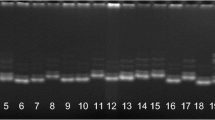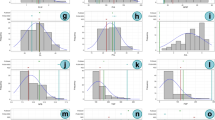Abstract
Assessment of genetic diversity in a crop germplasm is a vital part of plant breeding. DNA markers such as microsatellite or simple sequence repeat markers have been widely used to estimate the genetic diversity in rice. The present study was carried out to decipher the pattern of genetic diversity in terms of both phenotypic and genotypic variability, and to assess the efficiency of random vis-à-vis QTL linked/gene based simple sequence repeat markers in diversity estimation. A set of 88 rice accessions that included landraces, farmer’s varieties and popular Basmati lines were evaluated for agronomic traits and molecular diversity. The random set of SSR markers included 50 diversity panel markers developed under IRRI’s Generation Challenge Programme (GCP) and the trait-linked/gene based markers comprised of 50 SSR markers reportedly linked to yield and related components. For agronomic traits, significant variability was observed, ranging between the maximum for grains/panicle and the minimum for panicle length. The molecular diversity based grou** indicated that varieties from a common centre were genetically similar, with few exceptions. The trait-linked markers gave an average genetic dissimilarity of 0.45 as against that of 0.37 by random markers, along with an average polymorphic information constant value of 0.48 and 0.41 respectively. The correlation between the kinship matrix generated by trait-linked markers and the phenotype based distance matrix (0.29) was higher than that of random markers (0.19). This establishes the robustness of trait-linked markers over random markers in estimating genetic diversity of rice germplasm.





Similar content being viewed by others
References
Botstein D., White R. L., Skolnick M. and Davis R. W. 1980 Construction of a genetic linkage map in man using restriction fragment length polymorphisms. Am. J. Hum. Genet. 32, 314–331.
Cho Y. G., Ishii T., Temnykh S., Chen X., Lipovich L., McCouch S. R. et al. 2000 Diversity of microsatellites derived from genomic libraries and GenBank sequences in rice (Oryza sativa L.). Theor. Appl. Genet. 100, 713–722.
Choudhary S., Sethy N. K., Shokeen B. and Bhatia S. 2009 Development of chickpea EST-SSR markers and analysis of allelic variation across related species. Theor. Appl. Genet. 118, 591–608.
Cordeiro G. M., Casu R., McIntyre C. L., Manners J. M. and Henry R. J. 2001 Microsatellite markers from sugarcane (Saccharum spp.) ESTs cross transferable to erianthus and sorghum. Plant Sci. 160, 1115–1123.
Felsenstein J. 1985 Confidence limits on phylogenies: An approach using the bootstrap. Evolution 39, 783–791.
Ford-Lloyd B. V., Jackson M. T. and Newbury H. J. 1997 Molecular markers and the management of genetic resources in seed genebanks: a case study of rice. In Biotechnology and plant genetic resources: conservation and use (ed. J. A. Callow, B. V. Ford-Lloyd and H. J. Newbury). CAB International, Wallingford, UK.
Garris A. J., Tai T. H., Coburn J., Kresovich S. and McCouch S. 2005 Genetic structure and diversity in Oryza sativa L. Genetics 169, 1631–1638.
Glaszmann J. C. 1987 Isozymes and classification of Asian rice varieties. Theor. Appl. Genet. 74, 21–30.
Gupta P. K., Rustgi S., Sharma S., Singh R., Kumar N. and Balyan H. S. 2003 Transferable EST-SSR markers for the study of polymorphism and genetic diversity in bread wheat. Mol. Genet. Genomics 270, 315–323.
Hammer Ø., Harper D. A. T. and Ryan P. D. 2001 PAST: Paleontological statistics software package for education and data analysis. Palaeontol. Electron. 4, 9.
Kovach M. J., Sweeney M. T. and McCouch S. R. 2007 New insights into the history of rice domestication. Trends Genet. 23, 578–587.
Kumar S., Bisht I. S. and Bhatt K. V. 2010 Assessment of genetic diversity among rice (Oryza sativa L.) landrace populations under traditional production using microsatellite (SSR) markers. Electron. J. Plant Breed. 1, 474–483.
Li Y.C., Korol A. B., Fahima T. and Nevo E. 2004 Microsatellites within genes: structure, function, and evolution. Mol. Biol. Evol. 21, 991–1007.
McCouch S. R., Chen X. and Cho Y. G. 2002 Sequence divergence of rice microsatellites in Oryza and other plant species. Mol. Genet. Genomics 268, 331–343.
Nagaraju J., Kathirvel M., Kumar R. R., Siddiq E. A. and Hasnain S. E. 2002 Genetic analysis of traditional and evolved basmati and non-basmati rice varieties by using fluorescence based ISSR PCR and SSR markers. Proc. Natl. Acad. Sci. USA 99, 5836–5841.
Perrier X. and Collet J. P. 2006 DARwin software (http://darwin.cirad.fr/).
Prabhu K. V., Somers D. J., Rakow G. and Gugel R. K. 1998 Molecular markers linked to white rust resistance in mustard Brassica juncea. Theor. Appl. Genet. 97, 865–870.
Rai M. 1999 Rice germplasm evaluation and enhancement in India: issues, status, options, and future plan of action. Proceedings of the International Symposium on Rice Germplasm Evaluation and Enhancement (ed. J. N. Rutger, J. F. Robinson and R. H. Dilday), pp. 83–91, Arkansas Agricultural Experiment Station, Fayetteville, Arkansas.
Ram S. G., Thiruvengadam V. and Vinod K. K. 2007 Genetic diversity among cultivars, landraces and wild relatives of rice as revealed by microsatellite markers. J. Appl. Genet. 48, 337–345.
Rosenberg M. S. and Anderson C. D. 2011 PASSaGE: pattern analysis, spatial statistics and geographic exegesis, version 2. Methods Ecol. Evol. 2, 229–232.
Saini N., Jain N., Jain S. and Jain R. K. 2004 Assessment of genetic diversity within and among basmati and non-basmati rice varieties using AFLP, ISSR and SSR markers. Euphytica 140, 133–146.
Singh B., Mishra M. K. and Naik R. K. 2010 Genetic diversity among some traditional aromatic rice (Oryza sativa L) varieties of orissa. Indian J. Agric. Res. 44, 141–145.
Sivaranjani A. K. P., Pandey M. K., Sudharshan I., Kumar G. R., Madhav M. S., Sundaram R. M. et al. 2010 Assessment of genetic diversity among basmati and non-basmati aromatic rices of India using SSR markers. Curr. Sci. 99, 221–226.
Song Z. P., Xu X., Wang B., Chen J. K. and Lu B. R. 2003 Genetic diversity in the northernmost Oryza rufipogon populations estimated by SSR markers. Theor. Appl. Genet. 107, 1492–1499.
Sundaram R. M., Naveenkumar B., Biradar S. K., Balachandran S. M., Mishra B., Ahmed M. I. et al. 2008 Identification of informative SSR markers capable of distinguishing hybrid rice parental lines and their utilization in seed purity assessment. Euphytica 163, 215–224.
Temnykh S., Park D. W., Ayres N., Cartinhour S., Hauck N., Lipovich L. et al. 2000 Map** and genome organization of microsatellite sequences in rice (Oryza sativa L.). Theor. Appl. Genet. 100, 697–712.
Vanniarajan C., Vinod K. K. and Pereira A. 2012 Molecular evaluation of genetic diversity and association studies in rice (Oryza sativa L.). J. Genet. 91, 9–19.
Varshney R. K., Graner A. and Sorrells M. E. 2005 Genic microsatellite markers in plants: features and applications. Trends Biotechnol. 23, 48–55.
Virk P. S., Newbury J. H., Bryan G. J., Jackson M. T. and Ford-Lloyd B. V. 2000 Are mapped or anonymous markers more useful for assessing genetic diversity? Theor. Appl. Genet. 100, 607–613.
Zhang T., Ni X-L., Jiang K-F., Deng H-F., He Q., Yang Q-H. et al. 2010 Relationship between heterosis and parental genetic distance based on molecular markers for functional genes related to yield traits in rice. Rice Sci. 17, 288–295.
Acknowledgements
This study was carried out under the project ‘Marker Assisted Creation of Heterotic Pools and Diversification of Male Sterility and Fertility Restoration System for Hybrid Seed Production in Rice’ funded by the Council of Scientific and Industrial Research (CSIR), Government of India, under The New Millennium Indian Technology Leadership Initiative (NMITLI).
Author information
Authors and Affiliations
Corresponding author
Additional information
[Yadav S., Singh A., Singh M. R., Goel N., Vinod K. K., Mohapatra T. and Singh A. K. 2013 Assessment of genetic diversity in Indian rice germplasm (Oryza sativa L.): use of random versus trait-linked microsatellite markers. J. Genet. 92, xx–xx]
Sheel Yadav and Ashutosh Singh contributed equally to this work.
Electronic Supplementary Material
Below is the link to the electronic supplementary material.
Rights and permissions
About this article
Cite this article
YADAV, S., SINGH, A., SINGH, M.R. et al. Assessment of genetic diversity in Indian rice germplasm (Oryza sativa L.): use of random versus trait-linked microsatellite markers. J Genet 92, 545–557 (2013). https://doi.org/10.1007/s12041-013-0312-5
Received:
Revised:
Accepted:
Published:
Issue Date:
DOI: https://doi.org/10.1007/s12041-013-0312-5




